A Multimodal Transport Model to Evaluate Transport Policies in the North of France
Abstract
:1. Introduction
2. The Study Region and Input Data
2.1. Census Data on Daily Trips
2.2. Cross-Border and Freight Transport
2.3. Incomes and the Synthetic Population
2.4. Infrastructure and Public Transport Services
3. Calibration
4. Transport Policies
- (i)
- free public transport on all the study region and
- (ii)
- road pricing in the agglomeration of Lille.
4.1. Free Public Transport
4.2. Road Pricing
4.3. Environmental Impacts
5. Conclusions
- Improvement of the calibration techniques. The procedure we have used is very simple and does not always converge, particularly when the number of control parameters is large (more than ten). The number of parameters increases, for example, when there are several groups of agents with respect to their income. In that case, a manual adjustment was necessary to complement the automatic update of model parameters. Appropriate procedures based on Broyden’s algorithm for non-linear equations [24] should yield better outcomes. By performing this, it will allow us to implement finer calibrations based on count data.
- A more comprehensive account of multimodal trips. In the current version, the combination of several transport modes is not sufficiently flexible and remains limited to some predetermined possibilities.
- Alternative formulation of the utility function. For instance, we use a basic formulation where all components enter linearly. More complex formulations are more consistent with microeconomic descriptions of the users’ choice. In particular, travel time uncertainty turns out to be an important determinant in the choice of the transport mode (and even the households’ location choice). Recent literature has focused on this topic, and several estimations confirm that travel time reliability is as important as the value of time [28].
Author Contributions
Funding
Institutional Review Board Statement
Informed Consent Statement
Data Availability Statement
Acknowledgments
Conflicts of Interest
Abbreviations
| CO | Dioxyde carbone |
| GTFS | General Transit Feed Specification |
| HBEFA | Handbook of emission factors for Road Transport |
| INSEE | National Institute of Statistics and Economic Studies |
| LCV | Light commercial vehicles |
| MATSim | Multi-Agent Transport Simulation |
| PM | Particulate Matter |
| TER | Regional Express Train |
| TERGV | Regional High Speed Train |
References
- Marek, W. Will the consequences of covid-19 trigger a redefining of the role of transport in the development of sustainable tourism? Sustainability 2021, 13, 1887. [Google Scholar]
- de Dios Ortúzar, J.; Willumsen, L.G. Modelling Transport; John Wiley & Sons: Hoboken, NJ, USA, 2011. [Google Scholar]
- Brotcorne, L.; De Wolf, D.; Gendreau, M.; Labbé, M. A dynamic user equilibrium model for traffic assignment in urban areas. In Transportation and Network Analysis: Current Trends; Kluwer Academic Publishers: Dordrecht, The Netherlands, 2002; pp. 49–69. [Google Scholar]
- McNally, M.G.; Rindt, C.R. The activity-based approach. In Handbook of Transport Modelling; Emerald Group Publishing Limited: Bingley, UK, 2007; pp. 55–73. [Google Scholar] [CrossRef] [Green Version]
- Axhausen, K.W.; Horni, A.; Nagel, K. The Multi-Agent Transport Simulation MATSim; Ubiquity Press: London, UK, August 2016. [Google Scholar] [CrossRef]
- Petru, J.; Krivda, V. An analysis of turbo roundabouts from the perspective of sustainability of road transportation. Sustainability 2021, 13, 2119. [Google Scholar] [CrossRef]
- Nguyen-Luong, D.; De Palma, A.; Motamedi, K.; Ouaras, H.; Picard, N. Simaurif: Simulation of the Interaction between Land Use and Transportation in the Region Ile-de-France (Paris Region). In European Transport Conference 2008; Proceedings; the Transportation Research Board: London, UK, 2008; Available online: https://trid.trb.org/view/919672 (accessed on 3 December 2021).
- Delons, J.; Coulombel, N.; Leurent, F. PIRANDELLO an Integrated Transport and Land-Use Model for the Paris Area. 2008. Available online: https://hal.archives-ouvertes.fr/hal-00319087/document (accessed on 3 December 2021).
- Palma, A.D.; Marchal, F. Real cases applications of the fully dynamic metropolis tool-box: An advocacy for large-scale mesoscopic transportation systems. Netw. Spat. Econ. 2002, 2, 347–369. [Google Scholar] [CrossRef]
- Raux, C.; Ma, T.-Y.; Lemoy, R.; Ovtracht, N. A luti agent-based model of Lyon area: Welfare analysis of some scenarios. In Proceedings of the Transport Research Arena 2014: Innovate Mobility, Mobilise Innovation, Paris, France, 14–17 April 2014. [Google Scholar]
- Vickrey, W. Pricing, metering, and efficiently using urban transportation facilities. Highw. Res. Rec. 1973, 476, 36–48. [Google Scholar]
- Kickhofer, B.; Hosse, D.; Turnera, K.; Tirachinic, A. Creating an Open Matsim Scenario From Open Data: The Case of Santiago de Chile. VSP Working Paper 16-02. TU Berlin. Transport Systems Planning and Transport Telematics. 2016. Available online: http://www.vsp.tu-berlin.de/publications (accessed on 3 December 2021).
- Abdallah, K.B.; Belloumi, M.; Wolf, D.D. International comparisons of energy and environmental efficiency in the road transport sector. Energy 2015, 93, 2087–2101. [Google Scholar] [CrossRef]
- Borger, B.D.; Glazer, A. Support and opposition to a pigovian tax: Road pricing with reference-dependent preferences. J. Urban Econ. 2017, 99, 31–47. [Google Scholar] [CrossRef]
- Goodwin, P.; Dargay, J.; Hanly, M. Elasticities of road traffic and fuel consumption with respect to price and income: A review. Transp. Rev. 2004, 24, 275–292. [Google Scholar] [CrossRef]
- Litman, T. Transit price elasticities and cross-elasticities. J. Public Transp. 2004, 7, 3. [Google Scholar] [CrossRef] [Green Version]
- Guzman, L.A.; Oviedo, D.; Cardona, R. Accessibility changes: Analysis of the integrated public transport system of bogotá. Sustainability 2018, 10, 3958. [Google Scholar] [CrossRef] [Green Version]
- Pilegaard, N.; Fosgerau, M. Cost benefit analysis of a transport improvement in the case of search unemployment. J. Transp. Econ. Policy JTEP 2008, 42, 23–42. [Google Scholar]
- David, Q. Gratuité des Transports en Commun et Congestion Routière: Revue de la Littérature et Implications Pour Paris; LEM, UMR 9221, Discussion Papers 2021-10; LIEPP Working Paper, Paris. 2021. Available online: https://hal.archives-ouvertes.fr/hal-03403442/ (accessed on 3 December 2021).
- Small, K.A.; Verhoef, E.T. The Economics of Urban Transportation; Routledge: London, UK, 2007. [Google Scholar]
- De Palma, A.; Kilani, M.; Lindsey, R. Congestion pricing on road network: A study using the dynamic equilibrium simulator metropolis. Transp. Res. A 2005, 39, 588–611. [Google Scholar] [CrossRef]
- Lara, M.D.; Palma, A.D.; Kilani, M.; Piperno, S. Congestion pricing and long term urban form: Application to paris region. Reg. Sci. Urban Econ. 2013, 43, 282–295. [Google Scholar] [CrossRef]
- Aboubacar, A.; Hammadou, H.; Kilani, M. Distribution des emplois et identification des sous-centres d’affaires dans l’agglomération lilloise. Rev. Deconomie Reg. Urbaine 2019, 5, 913–936. [Google Scholar] [CrossRef]
- Broyden, C.G. A class of methods for solving nonlinear simultaneous equations. Math. Comput. 1965, 19, 577–593. [Google Scholar] [CrossRef]
- Gonzalez-Feliu, J.; Semet, F.; Routhier, J.-L. Sustainable Urban Logistics: Concepts, Methods and Information Systems; Springer: Berlin/Heidelberg, Germany, 2014. [Google Scholar]
- de Carvalho, N.L.; Vieira, J.G.V.; da Fonseca, P.N.; Dulebenets, M.A. A multi-criteria structure for sustainable implementation of urban distribution centers in historical cities. Sustainability 2020, 12, 5538. [Google Scholar] [CrossRef]
- Katsela, K.; Güneş, S.; Fried, T.; Goodchild, A.; Browne, M. Defining urban freight microhubs: A case study analysis. Sustainability 2022, 14, 532. [Google Scholar] [CrossRef]
- de Jong, G.C.; Bliemer, M.C. On including travel time reliability of road traffic in appraisal. Transp. Res. Part Policy Pract. 2015, 73, 80–95. [Google Scholar] [CrossRef]
- Alessandrini, A.; Campagna, A.; Site, P.D.; Filippi, F.; Persia, L. Automated vehicles and the rethinking of mobility and cities. Transp. Res. Procedia 2015, 5, 145–160. [Google Scholar] [CrossRef] [Green Version]
- Wang, X.; Liu, S.; Shi, H.; Xiang, H.; Zhang, Y.; He, G.; Wang, H. Impact of penetrations of connected and automated vehicles on lane utilization ratio. Sustainability 2022, 14, 474. [Google Scholar] [CrossRef]
- Sechel, I.C.; Mariasiu, F. Efficiency of governmental policy and programs to stimulate the use of low-emission and electric vehicles: The case of romania. Sustainability 2022, 14, 45. [Google Scholar] [CrossRef]
- Vishnu, N.; Kameshwar, S.; Padgett, J.E. Road Transportation Network Hazard Sustainability and Resilience: Correlations and Comparisons. Struct. Infrastruct. Eng. 2021, 1–21. Available online: https://doi.org/10.1080/15732479.2021.1945114 (accessed on 3 December 2021). [CrossRef]
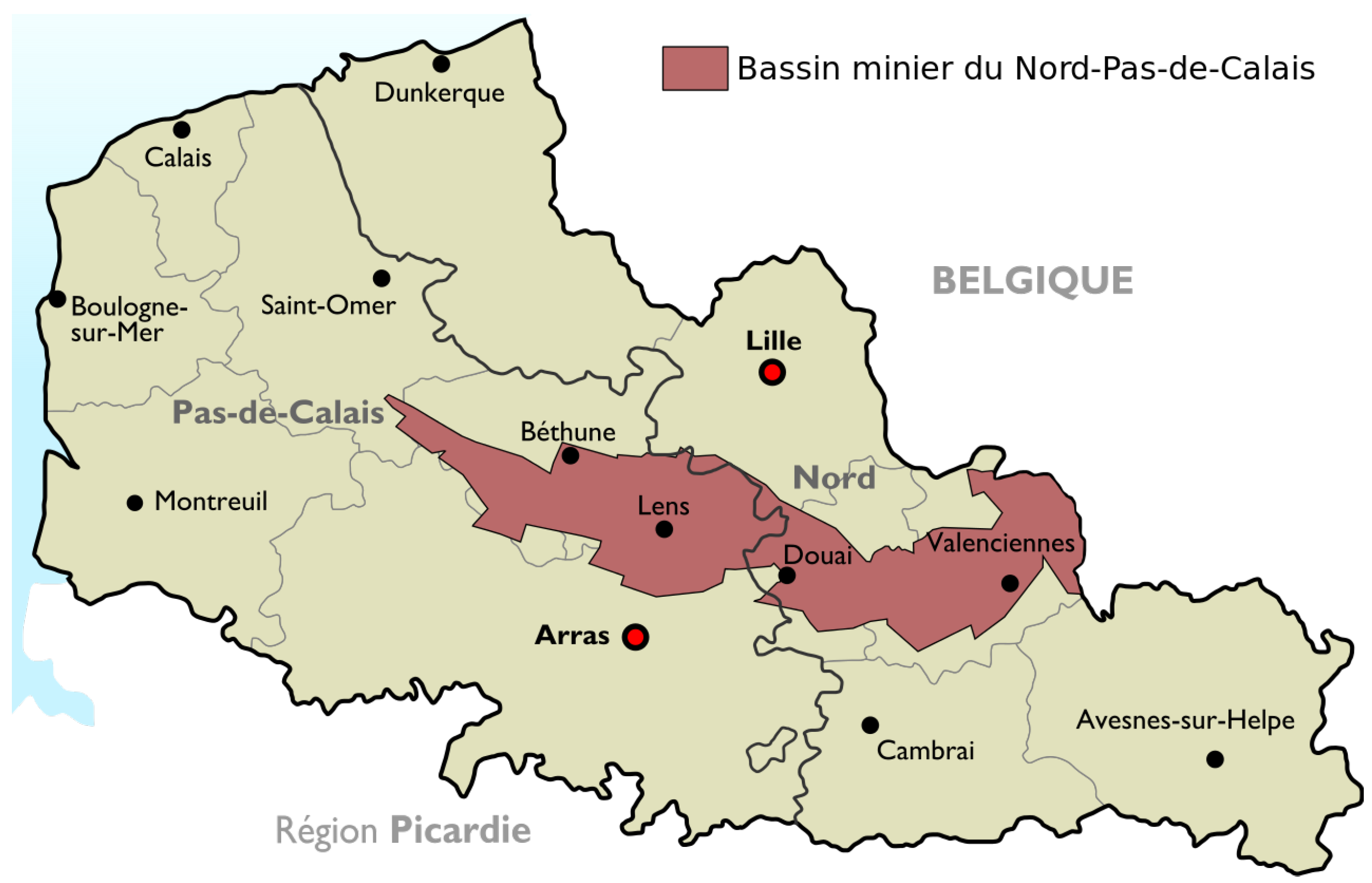
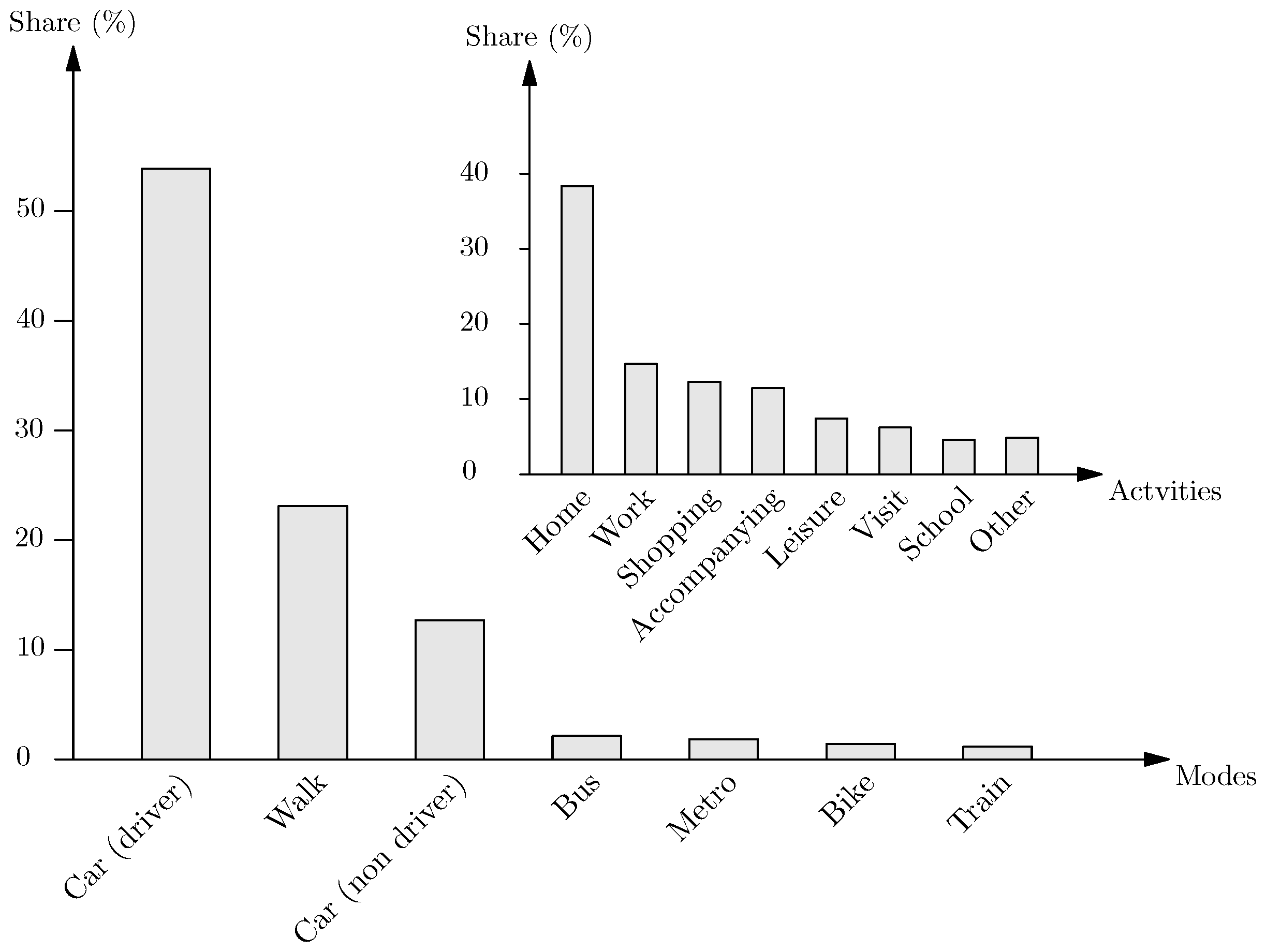
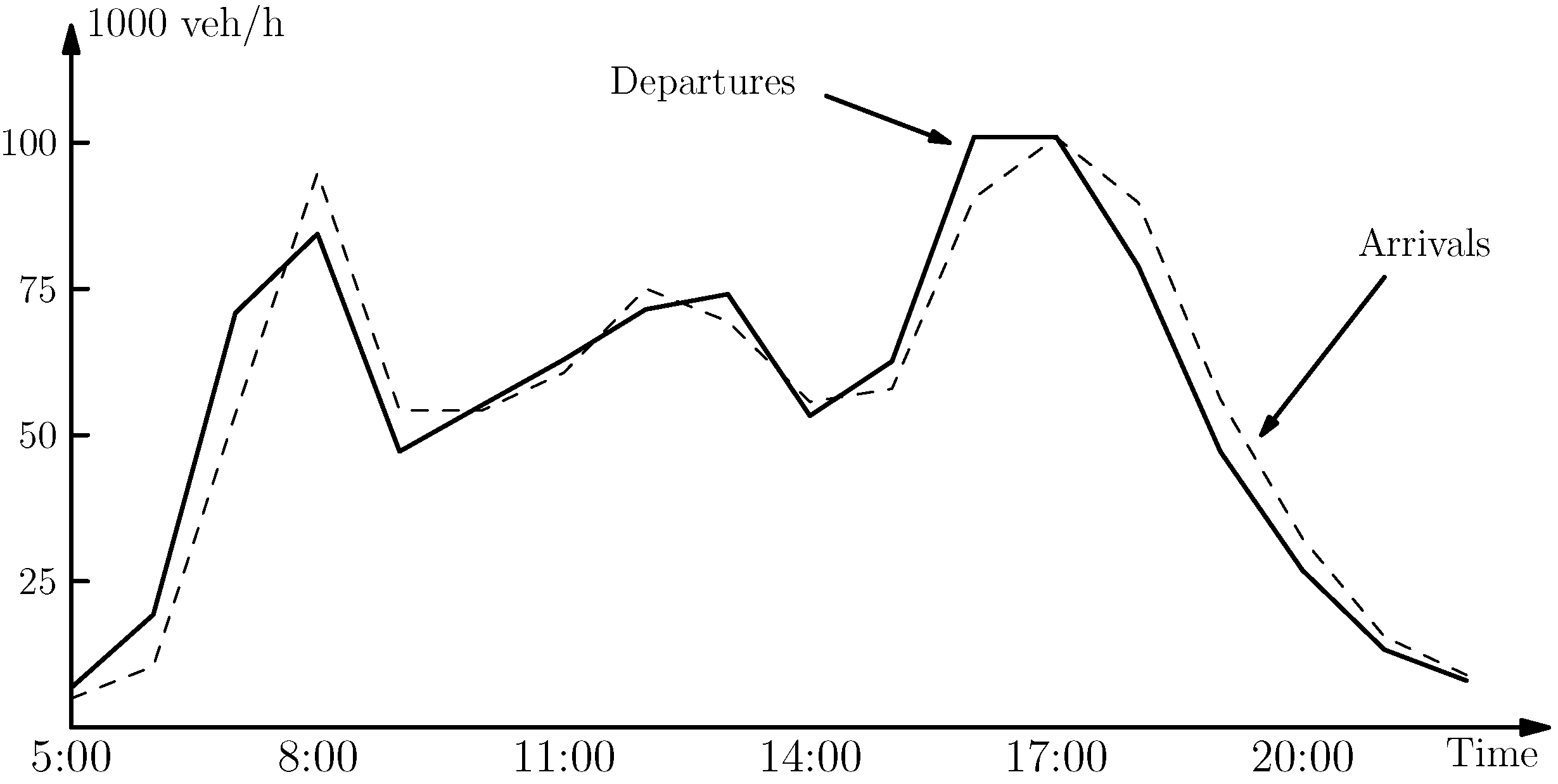


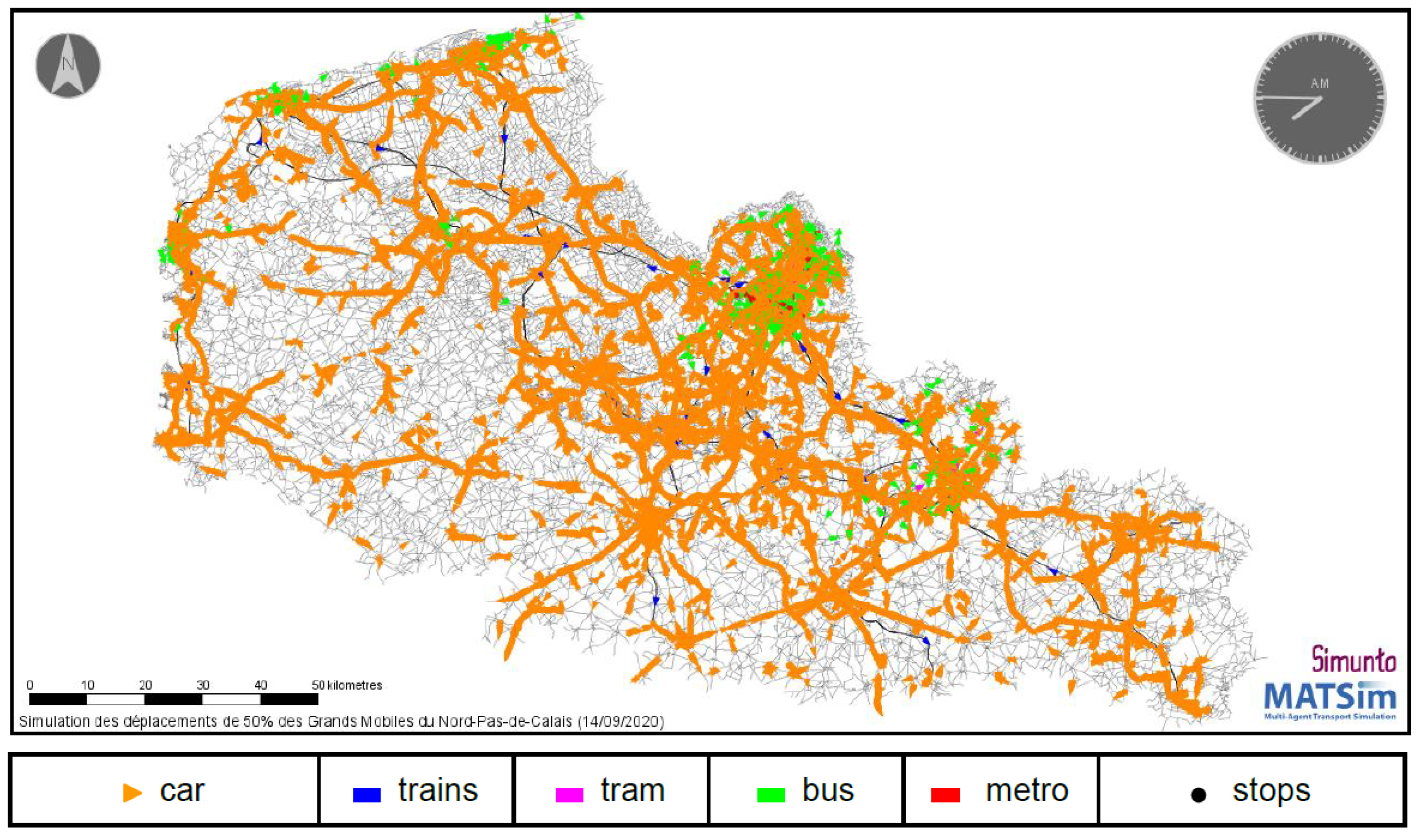
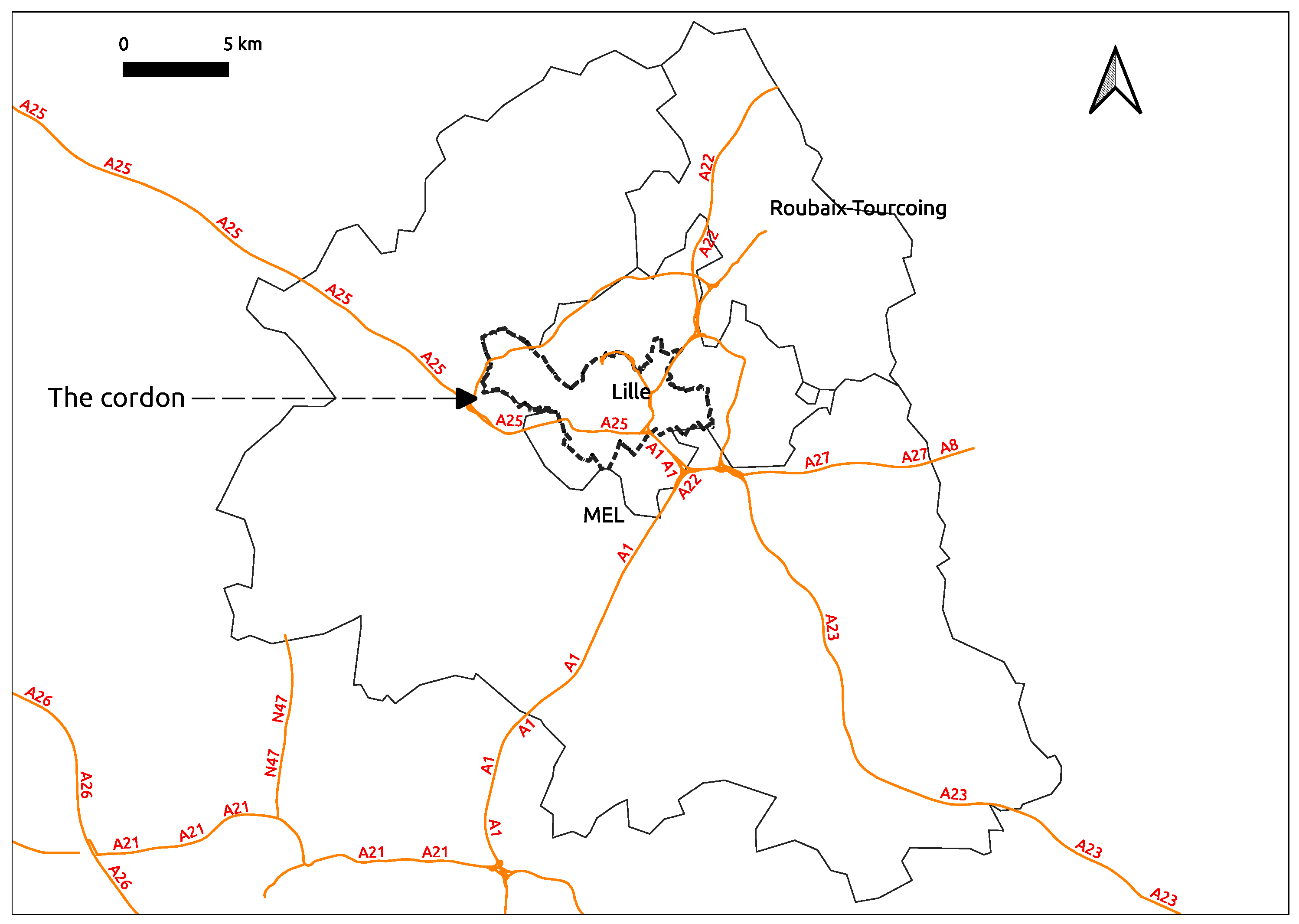
| User Groups (by Income) | |||||
|---|---|---|---|---|---|
| Modes | Low | Medium | High | Total | (%) |
| Regional model: Nord and Pas-de-Calais | |||||
| bike | 7368 | 21,000 | 11,321 | 39,689 | 2.70 |
| car | 142,677 | 465,000 | 259,694 | 867,371 | 59.05 |
| pt | 14,348 | 41,974 | 28,641 | 84,963 | 5.78 |
| walk | 85,281 | 246,771 | 144,791 | 476,843 | 32.46 |
| Urban model: Lille | |||||
| bike | 1809 | 5721 | 4020 | 11,550 | 2.01 |
| car | 31,548 | 125,928 | 104,347 | 261,823 | 45.57 |
| pt | 11,485 | 31,716 | 24,110 | 67,311 | 11.71 |
| walk | 39,482 | 111,900 | 82,516 | 233,898 | 40.71 |
| User Groups (by Income) | ||||
|---|---|---|---|---|
| Modes | Low | Medium | High | Total |
| bike | −28.14% | −17.73% | −9.71% | −17.47% |
| car | −18.62% | −8.40% | −3.37% | −8.82% |
| pt | +115.06% | +55.18% | +18.82% | +54.24% |
| walk | +14.22% | +7.95% | +3.07% | +7.84% |
| User Groups (by Income) | ||||
|---|---|---|---|---|
| Modes | Low | Medium | High | Total |
| bike | +2.51% | +0.26% | −0.99% | +0.25% |
| car | −11.68% | −4.47% | −0.87% | −4.02% |
| pt | +9.92% | +6.12% | +1.27% | +5.14% |
| walk | +6.33% | +3.29% | +0.77% | +3.01% |
| User Groups (by Income) | ||||
|---|---|---|---|---|
| Modes | Low | Medium | High | Total |
| Nord and Pas-de-Calais model: Diesel car | ||||
| CO | −15.08% | −4.01% | −2.30% | −5.11% |
| PM | −14.96% | −4.01% | −2.35% | −5.10% |
| Fuel | −14.95% | −3.98% | −2.27% | −5.06% |
| Nord and Pas-de-Calais model: Petrol car | ||||
| CO | −13.82% | −4.92% | −2.23% | −5.33% |
| PM | −13.84% | −4.89% | −2.32% | −5.35% |
| Fuel | −13.70% | −3.88% | −2.19% | −5.28% |
| User Groups (by Income) | ||||
|---|---|---|---|---|
| Modes | Low | Medium | High | Total |
| Lille Metropole model: Diesel car | ||||
| CO | −10.15% | −3.31% | −0.85% | −3.04% |
| PM | −10.02% | −3.19% | −0.75% | −2.92% |
| Fuel | −10.12% | −3.28% | −0.83% | −3.01% |
| Lille Metropole model: Petrol car | ||||
| CO | −6.13% | −3.94% | −1.42% | −3.15% |
| PM | −6.47% | −3.77% | −1.32% | −3.06% |
| Fuel | −6.14% | −3.89% | −1.41% | −3.12% |
Publisher’s Note: MDPI stays neutral with regard to jurisdictional claims in published maps and institutional affiliations. |
© 2022 by the authors. Licensee MDPI, Basel, Switzerland. This article is an open access article distributed under the terms and conditions of the Creative Commons Attribution (CC BY) license (https://creativecommons.org/licenses/by/4.0/).
Share and Cite
Kilani, M.; Diop, N.; De Wolf, D. A Multimodal Transport Model to Evaluate Transport Policies in the North of France. Sustainability 2022, 14, 1535. https://doi.org/10.3390/su14031535
Kilani M, Diop N, De Wolf D. A Multimodal Transport Model to Evaluate Transport Policies in the North of France. Sustainability. 2022; 14(3):1535. https://doi.org/10.3390/su14031535
Chicago/Turabian StyleKilani, Moez, Ngagne Diop, and Daniel De Wolf. 2022. "A Multimodal Transport Model to Evaluate Transport Policies in the North of France" Sustainability 14, no. 3: 1535. https://doi.org/10.3390/su14031535
APA StyleKilani, M., Diop, N., & De Wolf, D. (2022). A Multimodal Transport Model to Evaluate Transport Policies in the North of France. Sustainability, 14(3), 1535. https://doi.org/10.3390/su14031535






